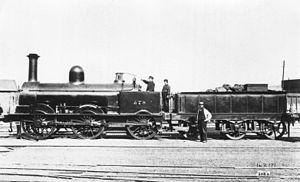LNWR DX Goods class
| LNWR DX Goods Class | |||||||||||||||||||||||||||||
|---|---|---|---|---|---|---|---|---|---|---|---|---|---|---|---|---|---|---|---|---|---|---|---|---|---|---|---|---|---|

No. 578 in original condition and livery
|
|||||||||||||||||||||||||||||
|
|||||||||||||||||||||||||||||
|
|||||||||||||||||||||||||||||
|
|||||||||||||||||||||||||||||
|
|||||||||||||||||||||||||||||
| Type and origin | |
|---|---|
| Power type | Steam |
| Designer | John Ramsbottom |
| Builder | Crewe works |
| Build date | 1858–1862 |
| Total produced | 943 |
| Specifications | |
|---|---|
| Configuration: |
|
| • Whyte | 0-6-0 |
| Gauge | 4 ft 8 1⁄2 in (1,435 mm) |
| Driver dia. | 5 ft 2 in (1.575 m) |
| Total weight | 27 long tons (27 t) (29 long tons (29 t) when fueled) |
| Water cap | 2,000 imp gal (9,100 L) |
| Firebox: • Firegrate area |
15 sq ft (1.4 m2) or 17.1 sq ft (1.59 m2) |
| Boiler | 4 ft 2 in (1.27 m) diameter x 10 ft 6 in (3.20 m) length |
| Boiler pressure | 120 psi (0.83 MPa) |
| Heating surface | 1,074 sq ft (99.8 m2) |
| Cylinders | two, inside |
| Cylinder size | 17 in (430 mm) diameter, 24 in (610 mm) stroke |
| Valve gear | Stephenson |
| Performance figures | |
|---|---|
| Tractive effort | 11,410 lbf (50.8 kN) |
| Career | |
|---|---|
| Operators | London and North Western Railway, Lancashire and Yorkshire Railway |
| Withdrawn | 1902–1930 |
| Disposition | All scrapped |
The London and North Western Railway (LNWR) DX Goods class was a class of 0-6-0 steam locomotive, designed by John Ramsbottom for freight duties. 943 were constructed making them the largest single class of locomotives built in the United Kingdom.
The "DX" goods engine was the first original design produced by Ramsbottom, shortly after becoming Locomotive Superintendent of the Northern Division. An experimental prototype was developed at Longsight whilst Ramsbottom was only in charge of the North-Eastern Division. The first regular example was completed at Crewe in September 1858, and was given the running number 355. This was the 399th locomotive built at Crewe, but it was the practice of the LNWR to reuse the numbers of withdrawn locomotives.
The first DX, No. 355, was named Hardman, and carried the name on a curved brass plate above the driving wheels. It was painted in the same dark green livery as used by Ramsbottom's predecessor, Francis Trevithick, but edged with a single black line. Fifty-four of the early DX locomotives were given names, but all were removed by 1864, with some re-used on passenger locomotives.
Four 0-4-2 versions of this locomotive type were built by Robert Stephenson and supplied to the Sydney Railway Company in 1855 as the first motive power for the new railway company. They were virtually identical in specification, except for slightly larger driving wheels at 5 ft 6 in (1.676 m) diameter and cylinders being a smaller 16-inch (410 mm) bore than the 17 in (432 mm) of the original design.
857 examples of Ramsbottom’s standard goods design were built for the LNWR at Crewe works between 1858 and 1872. The class has been described as ‘the earliest example of standardization and mass productions of locomotives on a large scale,' and ‘a remarkable instance of standardisation at a time when most railways had many different classes, each class with only few engines.’. During the 1870s driving cabs were added. 278 examples of a saddle tank version of the design were built after 1870, known as the LNWR Special Tank.
In addition to the 857 examples used by the LNWR, a further 86 examples of the original design were constructed at Crewe for the Lancashire and Yorkshire Railway between 1871 and 1874. This alarmed independent locomotive manufacturers, who sought an injunction to stop the practice; granted on 16 December 1875. In April 1881 Francis Webb rebuilt 500 examples with a new 150 psi boiler and vacuum brakes for working passenger trains. These became known as ‘Special’ (or vacuum) DX’s.
...
Wikipedia
